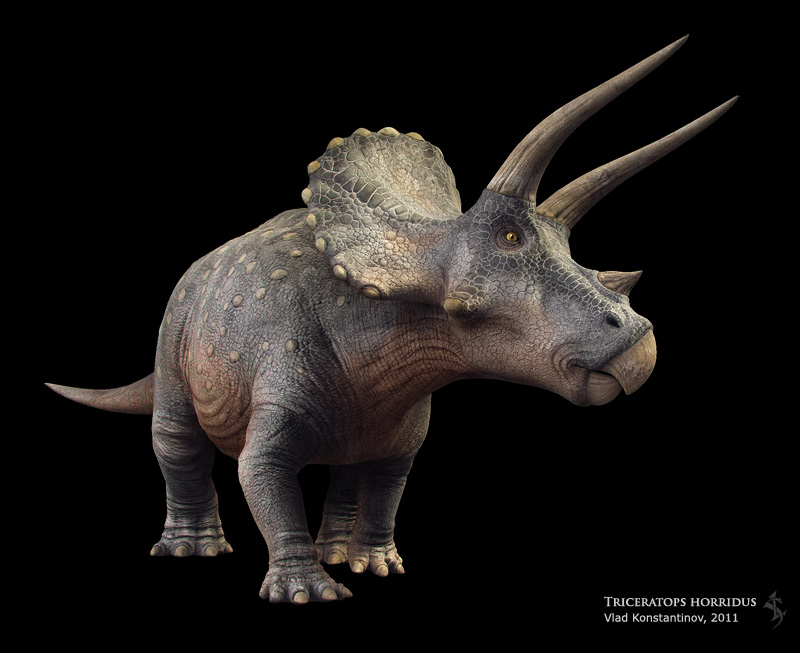|
|
Post by dinosauria101 on Jul 10, 2019 18:49:45 GMT 5
Mamenchisaurus spp.  upload.wikimedia.org/wikipedia/commons/thumb/7/74/Mamench_DB.jpg/800px-Mamench_DB.jpg upload.wikimedia.org/wikipedia/commons/thumb/7/74/Mamench_DB.jpg/800px-Mamench_DB.jpgOrder: Sauropoda Family: Mamenchisauridae Length: 13 to 35 meters, depending on species Mass: 5 to 75 tonnes, depending on species Diet: Plants Age and Location: Mid Jurassic to Early Cretaceous, 160 to 114 million years ago, China Weapons: Tail whip, manual claws Had a very long neck relative to its size. Some species among the largest dinosaurs ever to exist Triceratops horridus  fc05.deviantart.net/fs71/f/2011/150/b/6/b64aa2e5bbf8f29377fe3a99b838e016-d3hmt69.jpg fc05.deviantart.net/fs71/f/2011/150/b/6/b64aa2e5bbf8f29377fe3a99b838e016-d3hmt69.jpgOrder: Ceratopsia Family: Chasmosauridae Length: 8-9 meters Mass: 8.6-14 tonnes Diet: Plants, possibly an omnivore. Age and Location: Late Cretaceous, 65 million years ago, Canada and United States Weapons: Horns, beak One of the most famous dinosaurs and often featured in popular culture. Had a solid frill for protection and is often likened to a rhinoceros because of its horns. NOTE: We can debate with different species of Mamenchisaurus to see which is fairest |
|
|
|
Post by elosha11 on Jul 13, 2019 9:22:13 GMT 5
Even the smallest sauropod seems too big. It could crush triceratops with its weight and bulk, although triceratops was probably a pretty good fighter (maybe like a rhino/hippo today and could do damage with its own power and horns). But unless it got the perfect running start and stab, the larger dino would overwhelm it (think elephant v. rhino but with even greater size disparity).
|
|
|
|
Post by dinosauria101 on Jul 13, 2019 18:32:04 GMT 5
Even the smallest sauropod seems too big. Well, there is a MASSIVE variation between different species of Mamenchisaurus. The outcome could be very different from species to species. Here is a breakdown of it all: Mamenchisaurus constructus: Not debatable, it's about half the weight of Triceratops on average at only 5 tons Mamenchisaurus youngi: Still not debatable, it's only about 7 tons Mamenchisaurus hochuanensis: It's about 18 tons. I'd favor it over a 6-9 ton Triceratops, but not a 12 ton specimen Mamenchisaurus anyuensis: 25 tons. Easily wins against 6-9 ton Triceratops, closer match with 12 ton Trike, but I'd still favor it Mamenchisaurus jingyanensis: Also 25 tons. Same as anyuensis. Mamenchisaurus sinocanadorum: 75 tons. Easily wins against all Triceratops specimens, 12 tons or not. Overall, I'd vote for Mamenchisaurus. But Triceratops has a fair chance of winning as well, especially against Mamenchisaurus constructus and Mamenchisaurus youngi. EDIT: elosha11 , just some food for thought; Triceratops may not be as chanceless as you think here. This GDI (link) gives a Triceratops with a 2.5 meter skull and total length of 8.26 meters a mass of about 10.5 tonnes, and I'd in fact argue it would be closer to 11-12 tonnes given that the parts of the head in red are excluded and that there is very little soft tissue on the legs, tail, and chest. Scaling this specimen to the size of the largest Trikes (2.75 meters skull length, AMNH 5040, about 9 meters) gives 14-15.11 tonnes when scaled up from 11 tonnes. That's not all - that 11-12 tonne specimen is still probably undersized at least a little bit. The width of the top view, using the 2.5 meter skull as a scale, is about 172 cm. The thing is, a smaller specimen of Triceratops called Kelsey, at 6-7 meters, is actually WIDER than this at 185 cm in top view (link). Thus, this 8.26 meter Triceratops has a smaller width than a 6-7 meter one and is therefore almost certainly underestimated in terms of mass. If we choose to go by direct scaling from Kelsey, this specimen would have a width of about 235 cm top view. As for the largest Triceratops specimens (AMNH 5040), the same would apply; they are about 187 cm wide directly scaling from the GDI as-is, but this also appears to be an underestimate as scaling from Kelsey would give us about 259 cm for the top view-width of these specimens. Overall, it's about 35% too narrow in top view Long story short, it's certainly on the table that even 10.5+ tonnes is a considerable underestimate for some Triceratops specimens (they would likely mass >14-15 tonnes with the proper width increase); only the very biggest Mamenchisaurus species (Mamenchisaurus sinocanadorum, 75 tonnes) would technically be 'safe' from them. Note that this mass estimate for Triceratops is by no means factual or set in stone whatsoever, it is merely a possibility of the mass range for Triceratops just like every other estimate for this species. However, it's quite possible that Trike has quite a bit more chance here than some may think. |
|